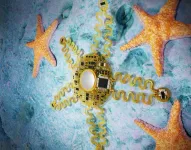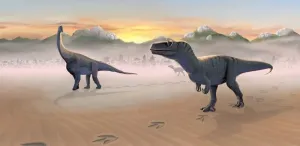(Press-News.org) Excessive screen time among adolescents negatively impacts multiple aspects of sleep, which in turn increases the risk of depressive symptoms — particularly among girls. That is the conclusion of a new study published this week in the open-access journal PLOS Global Public Health by Sebastian Hökby of Karolinska Institutet, Sweden, and colleagues.
Recently, the Swedish Public Health Agency published recommendations that adolescents use no more than two-to-three hours of daily leisure screen time, partly to promote better sleep. Previous studies have suggested associations between screen time, sleep disruptions, and depression in teens. However, sleep problems and depression often coincide, and the direction of these associations has been unclear.
In the new study, researchers tracked 4,810 Swedish students aged 12-16, collecting data on sleep quality and quantity, depressive symptoms, and screen usage at three timepoints over the course of a year.
The researchers found that increased screen time led to deteriorated sleep within three months, impacting both the duration and quality of sleep. Screen time was also found to postpone sleep times towards later hours – disrupting multiple aspects of the human sleep-wake cycle at once. Among boys, screen time had a direct adverse effect on depression after twelve months, while among girls the depressive effect was mediated through sleep disturbances. Sleep could explain about half (38%-57%) of the association between screen time and depression in girls. Boys who spent more time on screens also experienced sleep disruptions, but these were not strongly associated to later depression.
The authors summarize: “In this study, we found that adolescents who reported longer screen times also developed poorer sleep habits over time. In turn, this led to increased depression levels, especially among girls.”
They add: “Our results do suggest that less[…] screen time seems healthier, in line with previous World Health Organization statements…if screen times were somehow reduced, for example through public health policies, our results imply that the high burden of depressive states among young Swedish women, and maybe young men, would likely decrease.”
####
In your coverage please use this URL to provide access to the freely available article in PLOS Global Public Health: https://plos.io/4lcseoX
Citation: Hökby S, Alvarsson J, Westerlund J, Carli V, Hadlaczky G (2025) Adolescents’ screen time displaces multiple sleep pathways and elevates depressive symptoms over twelve months. PLOS Glob Public Health 5(4): e0004262. https://doi.org/10.1371/journal.pgph.0004262
Author Countries: Sweden
Funding: The author(s) received no specific funding for this work.
END
Study links teen girls’ screen time to sleep disruptions and depression
The association between screen time and depression may be mediated by poor sleep, the new findings suggest.
2025-04-02
ELSE PRESS RELEASES FROM THIS DATE:
Scientists unveil starfish-inspired wearable tech for heart monitoring
2025-04-02
When we move, it’s harder for existing wearable devices to accurately track our heart activity. But University of Missouri researchers found that a starfish’s five-arm shape helps solve this problem.
Inspired by how a starfish flips itself over — shrinking one of its arms and using the others in a coordinated motion to right itself — Sicheng Chen and Zheng Yan in Mizzou’s College of Engineering and collaborators have created a starfish-shaped wearable device that tracks heart health in real time.
Because the starfish-inspired device has multiple points touching the skin near the heart, it stays more ...
Footprints reveal prehistoric Scottish lagoons were stomping grounds for giant Jurassic dinosaurs
2025-04-02
Jurassic dinosaurs milled about ancient Scottish lagoons, leaving up to 131 footprints at a newly discovered stomping ground on the Isle of Skye in Scotland, according to a study published April 2, 2025 in the open-access journal PLOS One by Tone Blakesley of the University of Edinburgh, Scotland and colleagues.
In the rocks of the Isle of Skye, dinosaur footprints are abundant, providing insights into dinosaur distribution and behavior during an important time in their evolution. The footprints were left in the rippled sands of an ancient subtropical lagoon, dating back to the Middle Jurassic ...
AI effectively predicts dementia risk in American Indian/Alaska Native elders
2025-04-02
Irvine, Calif., April 2, 2025 — Machine learning algorithms utilizing electronic health records can effectively predict two-year dementia risk among American Indian/Alaska Native adults aged 65 years and older, according to a University of California, Irvine-led study. The findings provide a valuable framework for other healthcare systems, particularly those serving resource-limited populations.
The computer modeling results also found several new predictors for dementia diagnosis that were identified consistently across different machine-learning models. Findings are published in the Lancet Regional Health – Americas. The National Institutes ...
First guideline on newborn screening for cystic fibrosis calls for changes in practice to improve outcomes
2025-04-02
The United States Cystic Fibrosis Foundation released the first guideline on newborn screening for cystic fibrosis (CF), in order to improve timely detection of CF in infants from all racial and ethnic backgrounds. The new guideline, based on systematic literature reviews and published in the International Journal of Neonatal Screening, reflects rigorous scientific investigation and perspectives from parents, CF specialists, public health representatives, primary care providers and genetic counselors.
CF is a genetic disorder that causes problems with digestion and breathing. Currently, newborns in every state are screened for ...
Existing international law can help secure peace and security in outer space, study shows
2025-04-02
World leaders should look to existing international law on the use of force to address the threat of space becoming ever more militarized, a new study shows.
Space has the potential to be a source and place of armed conflict and regulating military activities in space is of pressing international concern.
Tests of anti-satellite (ASAT) weapons have fuelled fears of warfare in space. Resulting space debris from ASAT weapon threatens other satellites in orbit, many of which underpin the operation of human societies and the functioning of global economies.
Conflict ...
Pinning down the process of West Nile virus transmission
2025-04-02
COLUMBUS, Ohio – Mosquitoes have been transmitting the West Nile virus to humans in the United States for over 25 years, but we still don’t know precisely how the virus cycles through these pests and the other animals they bite.
A federally funded project aims to help pin down the process by using mathematical models to analyze how factors like temperature, light pollution, and bird and mosquito abundance affect West Nile virus transmission. The ultimate goal is to advise health departments of the best time of year to kill the bugs.
“I’m hopeful that what we will uncover in this grant will help us to better understand what’s driving West Nile virus transmission, ...
UTA-backed research tackles health challenges across ages
2025-04-02
Genevieve Graaf spent years as a mental health social worker specializing in children and youth with complex behavioral health needs. Many had to travel to other states or hundreds of miles from family to access adequate medical care. Drawing on her experience, Dr. Graaf, an assistant professor of social work at The University of Texas at Arlington, has continuously sought ways to improve community-based support programs and ease the burden on families.
She will build on that work with her latest research through UT Arlington’s Center ...
In pancreatic cancer, a race against time
2025-04-02
Pancreatic cancer is projected to become the second-deadliest cancer by 2030. By the time it’s diagnosed, it’s often difficult to treat. So, for both individual patients and the general population, fighting pancreatic cancer can feel like a race against time. Cold Spring Harbor Laboratory (CSHL) Professor and Cancer Center Director David Tuveson offers a telling analogy:
“We all have moles on our skin. Most of your moles are fine. But some of your moles you have a dermatologist looking at to make sure it’s always fine. They ...
Targeting FGFR2 may prevent or delay some KRAS-mutated pancreatic cancers
2025-04-02
Bottom Line: Precancerous pancreatic lesions and some pancreatic ductal adenocarcinoma (PDAC) tumors harboring KRAS mutations had higher-than-normal expression of the FGFR2 protein, and FGFR2 inactivation delayed KRAS-mutated PDAC development in mice.
Journal in Which the Study was Published: Cancer Research, a journal of the American Association for Cancer Research
Author: Claudia Tonelli, PhD, a research investigator in the laboratory of AACR Past President David A. Tuveson, MD, PhD, FAACR, at Cold Spring Harbor Laboratory
Background: PDAC is the most common ...
Melodies of musical ‘starquakes’ shed new light on how our galaxy formed
2025-04-02
They say music is the universal language of humankind, but some stars in our galaxy exhibit their own rhythm, offering fresh clues into how they and our galaxy evolved over time.
According to an international team of researchers, including scientists from The Australian National University (ANU) and UNSW Sydney, some stars exhibit fluctuations in their brightness over time, which are caused by continuous ‘starquakes’.
These fluctuations can be translated into frequencies, which can be used to determine a star’s age and other properties ...
LAST 30 PRESS RELEASES:
Why nail-biting, procrastination and other self-sabotaging behaviors are rooted in survival instincts
Regional variations in mechanical properties of porcine leptomeninges
Artificial empathy in therapy and healthcare: advancements in interpersonal interaction technologies
Why some brains switch gears more efficiently than others
UVA’s Jundong Li wins ICDM’S 2025 Tao Li Award for data mining, machine learning
UVA’s low-power, high-performance computer power player Mircea Stan earns National Academy of Inventors fellowship
Not playing by the rules: USU researcher explores filamentous algae dynamics in rivers
Do our body clocks influence our risk of dementia?
Anthropologists offer new evidence of bipedalism in long-debated fossil discovery
Safer receipt paper from wood
Dosage-sensitive genes suggest no whole-genome duplications in ancestral angiosperm
First ancient human herpesvirus genomes document their deep history with humans
Why Some Bacteria Survive Antibiotics and How to Stop Them - New study reveals that bacteria can survive antibiotic treatment through two fundamentally different “shutdown modes”
UCLA study links scar healing to dangerous placenta condition
CHANGE-seq-BE finds off-target changes in the genome from base editors
The Journal of Nuclear Medicine Ahead-of-Print Tip Sheet: January 2, 2026
Delayed or absent first dose of measles, mumps, and rubella vaccination
Trends in US preterm birth rates by household income and race and ethnicity
Study identifies potential biomarker linked to progression and brain inflammation in multiple sclerosis
Many mothers in Norway do not show up for postnatal check-ups
Researchers want to find out why quick clay is so unstable
Superradiant spins show teamwork at the quantum scale
Cleveland Clinic Research links tumor bacteria to immunotherapy resistance in head and neck cancer
First Editorial of 2026: Resisting AI slop
Joint ground- and space-based observations reveal Saturn-mass rogue planet
Inheritable genetic variant offers protection against blood cancer risk and progression
Pigs settled Pacific islands alongside early human voyagers
A Coral reef’s daily pulse reshapes microbes in surrounding waters
EAST Tokamak experiments exceed plasma density limit, offering new approach to fusion ignition
Groundbreaking discovery reveals Africa’s oldest cremation pyre and complex ritual practices
[Press-News.org] Study links teen girls’ screen time to sleep disruptions and depressionThe association between screen time and depression may be mediated by poor sleep, the new findings suggest.






